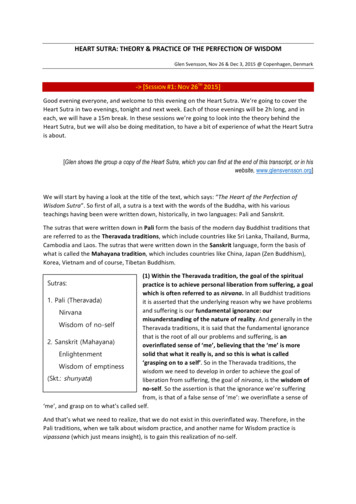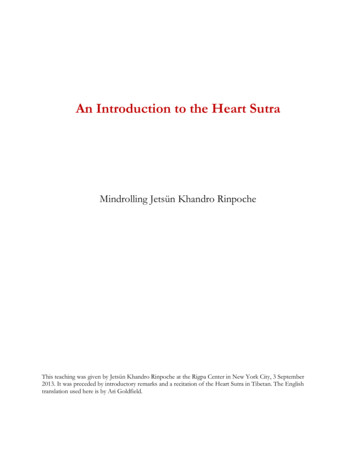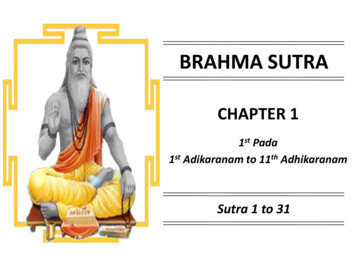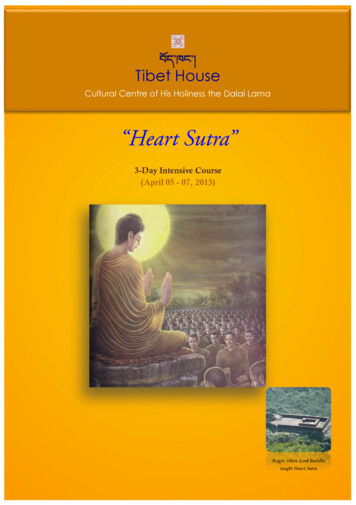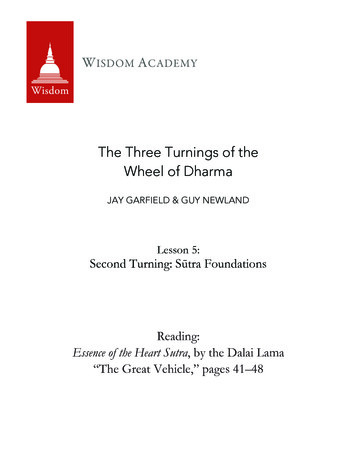
Transcription
W ISDOM A CADEMYThe Three Turnings of theWheel of DharmaJAY GARFIELD & GUY NEWLANDLesson 5:Second Turning: Sūtra FoundationsReading:Essence of the Heart Sutra, by the Dalai Lama“The Great Vehicle,” pages 41–48
Essence of theHeart SutraThe Dalai Lama’sHeart of Wisdom TeachingsTenzin Gyatsothe Fourteenth Dalai LamaTranslated and Editedby Geshe Thupten JinpaFor Students of Wisdom Academy—Not for Distribution
Wisdom Publications199 Elm StreetSomerville MA 02144 USAwisdompubs.org 2005, 2015 Tenzin Gyatso, the Fourteenth Dalai LamaAll rights reserved.No part of this book may be reproduced in any form or by any means, electronic ormechanical, including photocopying, recording, or by any information storage andretrieval system or technologies now known or later developed, without permissionin writing from the publisher.Library of Congress Cataloging-in-Publication DataBstan-’dzin-rgya-mtsho, Dalai Lama XIV, 1935–Essence of the Heart Sutra : the Dalai Lama’s heart of wisdom teachings / Tenzin Gyatso,the Fourteenth Dalai Lama ; translated and edited by Geshe Thupten Jinpa.— 1st pbk. ed.p. cm.Originally published: 2002.Includes bibliographical references and index.ISBN 0-86171-284-6 (pbk. : alk. paper)1. Tripiṭaka. Sūtrapiṭaka. Prajñāpāramitā. Hṛdaya—Criticism and interpretation. 2. Religious life—Buddhism. 3. Compassion—Religious aspects—Buddhism. 4. Buddhism—Doctrines. I. Thupten Jinpa. II. Tripiṭaka. Sūtrapiṭaka. Prajñāpāramitā. Hṛdaya. English.III. Title.BQ1967.B78 2005294.3’85—dc222005009870ISBN 978-0-86171-284-7ebook ISBN 978-0-86171-980-818 17 16876Cover image is a Tibetan text of the Large Perfection of Wisdom Sutra, courtesy of Tibetan Collection, Asian Division, Library of Congress. The Heart Sutra is said to contain the essence of allthe Perfection of Wisdom Sutras.Author photo by Nels Ackerlund.Interior design: Gopa&Ted2, Inc.For Students of Wisdom Academy—Not for Distribution
chapter 4The Great VehicleThe Mahayana SchoolIn order to fully understand the Heart Sutra, we must understand its place within the entire canon of Buddhist literature. TheHeart Sutra is part of the Perfection of Wisdom literature, which iscomposed of distinctly Mahayana (“Great Vehicle”) texts. TheseMahayana texts form the core of the “second turning of the wheelof Dharma.” The Mahayana teachings are rooted in the sermonsthat the Buddha taught primarily at Vulture Peak. Whereas theteachings of the first turning emphasize suffering and its cessation,the teachings of the second turning emphasize emptiness.In the Mahayana school there are also teachings that come fromthe “third turning of the wheel of Dharma.” Within these, we canspeak of two categories of scriptures: those scriptures that presentan interpretive reading of the Perfection of Wisdom sutras, andthose that present the theory of buddha nature (the Sanskrit wordfor this nature is tathagatagarbha). Because the Perfection of Wisdomliterature emphasizes emptiness, the interpretative readings of themin the third turning were taught primarily for the benefit of spiritual practitioners who, although inclined toward the Mahayana path,are not yet ready to properly make use of Buddha’s teachings on the41For Students of Wisdom Academy—Not for Distribution
42 Essence of the Heart Sutraemptiness of inherent existence. If such trainees were to embrace theapparent literal meaning of the Perfection of Wisdom sutras beforeseeing into the Buddha’s true meaning, they would be in danger offalling into the extreme of nihilism. It is important to know that theBuddha’s teachings are most certainly not nihilistic as that term isunderstood by philosophers, nor does the Buddha’s teaching on theemptiness of inherent existence entail mere nonexistence.One way of avoiding the extreme of nihilism is by contextualizing emptiness in terms of specific phenomena. For instance, inthe Sutra Unraveling the Thought of the Buddha (Samdhinirmochana Sutra), theBuddha offers a way of understanding the Perfection of Wisdomsutras by contextualizing the notion of “identitylessness.”8Nagarjuna and the Great VehicleAlthough the Tibetan tradition attributes the origin of the Mahayanateachings to the Buddha himself, scholars from other sects have historically expressed doubts on this matter, and some contemporaryscholars do so as well. It seems that even before the time of Nagarjuna (a great Buddhist teacher in India who lived around the secondcentury c.e.) there were contrasting opinions about this. Consequently, we find in Nagarjuna’s writings, such as the Precious Garland(Ratnavali), an entire section in which Nagarjuna attempts to prove theauthenticity of the Mahayana sutras. We also find such arguments inMaitreya’s Ornament of Mahayana Sutras (Mahayana Sutralamkara), in Shantideva’s Guide to the Bodhisattva’s Way of Life (Bodhicharyavatara), and inBhavaviveka’s Essence of the Middle Way (Madhyamakahridaya).For our purposes, let’s examine the core of Nagarjuna’s argument: If the path taught in the first turning of the wheel—theFor Students of Wisdom Academy—Not for Distribution
The Great Vehicle 43thirty-seven aspects of the path to enlightenment—were the onlypath to enlightenment taught by the Buddha, then there would be nosubstantial difference between the spiritual process leading to the fullenlightenment of a buddha and that leading to the individual liberation attained by an arhat. Another way of saying this would be thatan individual who attained nirvana (the elimination of one’s own suffering) would be identical in understanding and abilities to one whoattained the complete enlightenment of a buddha. If it is the case thatthese two states are identical, then the only substantial differencebetween them would be the time it takes to attain them: In order toattain buddhahood one must accumulate merit for three innumerableeons, whereas the individual liberation of an arhat can be attained farmore quickly. Nagarjuna argues, however, that such a position (thatthe states are identical but for the time involved) is untenable.Nagarjuna points out that one of the metaphysical ideas currentin the earlier Buddhist traditions is that at the time of the Buddha’s finalnirvana, which is known as “nirvana without residue”—conventionally,the point of death—the continuum of the being comes to an end.If this were the case, he argues, then the period of time during whichBuddha Shakyamuni was able to work for the welfare of other sentient beings following his full awakening, which was his primary reason for accumulating merit and wisdom over three innumerableeons, was extraordinarily short. The Buddha left his royal life at theage of twenty-nine, attained full enlightenment at the age of thirtysix, and passed away at the age of eighty or eighty-one. This wouldimply that the Buddha was able to work for the benefit of othersentient beings for only a few decades. For Nagarjuna, this hugedisparity between the duration of the Buddha’s training and theduration of his activity after enlightenment does not make sense.For Students of Wisdom Academy—Not for Distribution
44 Essence of the Heart SutraHe further argues that there is no basis for positing that thecontinuum of an individual’s mind would come to an end upon theattainment of final nirvana, because there is nothing that can bringabout the total cessation of the continuum of consciousness. Heasserts that if there is a sufficient antidote to any given phenomenonor event, then that antidote can be said to cause the complete cessation of the functioning of that phenomenon or event. (For example, a sufficient antidote of a bodily poison would cause thecomplete cessation of the functioning of that poison.) However,insofar as continuum of consciousness itself is concerned, no eventor an agent can bring about its total destruction. Nagarjuna arguesthat the innate mind and the defilements or afflictions that obscureits inherent clarity are two separate things. Mental pollutants—defilements and afflictions—can be eliminated by practicing thepowerful antidotes of the Buddha’s teachings. However, the continuum of the mind itself remains endless.Nagarjuna claims that not only are the teachings found in theSanskrit Mahayana tradition more profound than the teachings ofthe Pali tradition, but also that they do not contradict the Pali teachings. In a sense, one could say that the Mahayana scriptures elaborate on themes presented and first developed in the earlier teachingsof the Buddha, giving deeper and more detailed explanations of theideas presented there. In this manner, Nagarjuna argues the authenticity of the Mahayana teachings.There is a process of reflection in the Sakya teachings of thePath and Fruition (Lamdré) that is helpful in determining the validity of teachings. This tradition speaks of four valid sources of knowledge:the valid scriptures of the Buddha, the valid commentaries, the validteacher, and one’s own valid experience. In terms of the historicalFor Students of Wisdom Academy—Not for Distribution
The Great Vehicle 45evolution of these four factors, one can say that the valid scriptures,those taught by the Buddha, came into being first. Based upon thereading and interpretation of these scriptures, many valid commentaries and treatises evolved, explaining the most profound meaningof the Buddha’s teachings. Nagarjuna’s work is an example of this.Then, based upon the study and practice of these valid commentaries, certain practitioners may have mastered or actualized thethemes presented in the scriptures and their commentaries, andthereby become valid teachers. Finally, on the basis of the teachingsgiven by such teachers, valid experience or realization grows in thehearts of practitioners.However, one becomes able to personally verify the validity ofthese four sources in a different order than that in which the sourceshistorically evolved: in order to develop deep conviction in the validity of the Buddha’s teachings, one first needs a degree of experienceof them. Thus one’s own valid experience becomes the first factor.When we speak of valid experience, there can be ordinary validexperiences and special ones. Although we may not possess extraordinary kinds of spiritual experiences at present, we can all attainordinary types of spiritual experience. For example, when we reflectdeeply upon the teachings on compassion, we can feel some impactin our minds and in our hearts—we feel aroused and experience adeep sense of unbearableness. Similarly, when we reflect on theteachings on emptiness and no-self, it may bring about a deeperimpact within us. These are spiritual experiences.Once one has such spiritual experiences, even at an ordinarylevel, one has a taste of what it feels like to truly have these realizations. Based on that little experience, one can more meaningfully be convinced of the validity of the great spiritual realizationsFor Students of Wisdom Academy—Not for Distribution
46 Essence of the Heart Sutrathat are talked about in the sutras, in the commentaries, and in thebiographies of the masters. This process of beginning with ourown experience and using it to verify the teachings and the teachers is quite important; one could say, in fact, that this is the onlyway open to us.In Fundamentals of the Middle Way, Nagarjuna pays homage to theBuddha as a valid teacher who taught the ultimate nature of reality,who embodies the principle of great compassion, and who, actingexclusively through the power of his compassion for all sentientbeings, has revealed the path that will lead to the overcoming of allerroneous views. Reflecting deeply upon our own experience, wewill become able to validate what Nagarjuna says for ourselves andmake our own determination of the authenticity of the Mahayanateachings.Origins of the Great VehicleAfter the Buddha’s death, his teachings were compiled by some ofhis principal disciples. This compilation actually happened at threedifferent points in time. It is certain that the Mahayana scriptureswere not part of the three compilations that today constitute whatis known as the Pali canon. Furthermore, when we examine theMahayana scriptures themselves, we find statements that seem problematic in various ways. For example, the Perfection of Wisdomsutras state that they were taught by the Buddha at Vulture Peak inRajagriha to a vast congregation of disciples. However, if you havevisited the site in present-day Rajgir, it is obvious that it is impossible for more than a few people to fit onto the summit. So, we haveto understand the truth of these accounts at a different level, a levelFor Students of Wisdom Academy—Not for Distribution
The Great Vehicle 47beyond the ordinary one confined by conventional notions of spaceand time.Nagarjuna and Asanga (another great Indian teacher, who livedin the fourth century c.e.) played a critical role in the compilationof the Mahayana scriptures. They are identified as its principal custodians and interpreters. However, there is a gap of at least fourhundred years between the death of the Buddha and the birth ofNagarjuna, and perhaps as many as nine hundred years differencebetween the Buddha’s death and the birth of Asanga. We mighttherefore ask what it is that ensures that the Mahayana scriptureswere indeed continually transmitted from the time of the Buddha tothe times of Nagarjuna and Asanga. In the Mahayana scriptures,that link is the bodhisattvas, such as Maitreya and Manjushri. It issaid that, in the case of Nagarjuna, it is the bodhisattva Manjushriwho transmits the lineage. Bhavaviveka explicitly states in his text TheBlaze of Reasoning (Tarkajvala) that the great bodhisattvas compiled theMahayana scriptures. These accounts create a rather complex picture.How are we to understand these statements about the originsof the Mahayana scriptures in relation to conventional notions oftime? We can probably say that the Mahayana scriptures were nottaught by the historical Buddha to the general public in any conventional sense.Furthermore, it may be the case that Mahayana scriptures, suchas the Perfection of Wisdom sutras, were taught to a group of afew individuals whom the Buddha regarded as most suited toreceive those teachings. This accords with the Buddhist assertionthat a buddha transmits teachings in ways tailored to the diverseaptitudes and diverse physiological and psychological states ofpractitioners.For Students of Wisdom Academy—Not for Distribution
48 Essence of the Heart SutraThus, in this context, the teachings may have been transmittedon a plane that transcends conventional understandings of time andspace. In this way, we may understand the origin of Mahayana texts,and the origin of the Heart Sutra.For Students of Wisdom Academy—Not for Distribution
The Heart Sutra is said to contain the essence of all the Perfection of Wisdom Sutras. Author photo by Nels Ackerlund. Interior design: Gopa&Ted2, Inc. For Students of Wisdom AcademyÑNot for Distribution. chapter 4 The Great Vehicle The Mahayana School In order to fully

